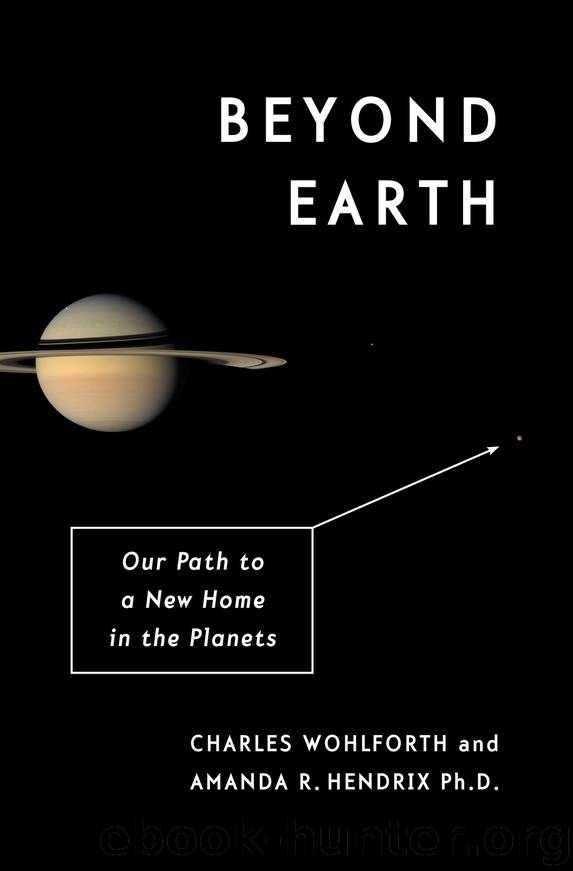Beyond Earth by Charles Wohlforth

Author:Charles Wohlforth
Language: eng
Format: epub
Publisher: Knopf Doubleday Publishing Group
Published: 2016-11-14T16:00:00+00:00
FUTURE
Technology for continuous acceleration in space developed extraordinarily rapidly, seemingly overnight, like flight after the Wright brothers or the Internet in the 1990s. As in those cases, however, the ideas that made it work didn’t spring from nowhere. For decades, creative engineers and scientists unafraid of working at the fringe of their professions had been thinking about far-out concepts and tinkering with prototypes without gaining much funding or respect. Suddenly, with the arrival of a pressing need came money and credibility. Conditions combined to rapidly grow the seeds of ideas, like sunflower sprouts, into something unexpectedly grand.
The CEO of Titan Corp., the independent corporation created for the Titan project, was immensely relieved when she received a successful demonstration of a functioning Q-drive. She had been promising for years a follow-up technology that would get people safely to Titan, where they could move into a habitat built by robots from slower ships that had already landed. Without her promised follow-up human mission, the huge expense of the robot missions, paid for by Titan Corp.’s funders in governments and large corporations, would go to waste.
The Titan mission architecture called for a group of six astronauts as pioneers. They would move into the small habitat prepared for them to direct robots in building larger, self-sustaining human habitats for more people to follow. They would also gather a sense of what it is like to live on Titan that no machine could express and would tell the world about it. But human beings could not survive a seven-year deep-space flight to Titan, like the flights the robots had taken and those flown by Earth’s earlier probes to the outer solar system. The mission would be possible only with a continuous-acceleration drive to get there in less than two years.
A conventional chemical rocket can produce a lot of thrust, but it needs heavy fuel for its brief burst of power. A spacecraft that produces just a little thrust but keeps it up can go much faster, even if it starts much slower. The ability to keep operating comes from higher density fuel—uranium rather than chemicals—and, in the case of the Q-drive, from the ability to harvest propellant from space rather than bringing it along. The Q-drive would gather up quantum particles that naturally come into existence and expel them through an electrical field, producing thrust. A nuclear reactor would produce the electricity for the field. With that compact power source and no need to carry propellant, the drive could continuously push the spacecraft forward, slowly gaining great speed.
With the prototype working, the next steps came rapidly. Money poured in from nervous governments and billionaire investors looking both for an escape from Earth and ground-floor ownership of a brand-new world. Titan Corp. leased a large space dock and heavy-lift commercial launch rockets to build the spacecraft. It bought seats on commercial spaceplanes to get assembly workers into orbit. As the work progressed, full-sized Q-drive thrusters came together, with huge rings like detached butterfly wings to accelerate quantum particles.
Download
This site does not store any files on its server. We only index and link to content provided by other sites. Please contact the content providers to delete copyright contents if any and email us, we'll remove relevant links or contents immediately.
| Aerodynamics | Aircraft Design & Construction |
| Astronautics & Space Flight | Avionics |
| Gas Dynamics | Propulsion Technology |
Whiskies Galore by Ian Buxton(41871)
Introduction to Aircraft Design (Cambridge Aerospace Series) by John P. Fielding(33064)
Small Unmanned Fixed-wing Aircraft Design by Andrew J. Keane Andras Sobester James P. Scanlan & András Sóbester & James P. Scanlan(32743)
Craft Beer for the Homebrewer by Michael Agnew(18140)
Turbulence by E. J. Noyes(7935)
The Complete Stick Figure Physics Tutorials by Allen Sarah(7307)
Kaplan MCAT General Chemistry Review by Kaplan(6866)
The Thirst by Nesbo Jo(6826)
Bad Blood by John Carreyrou(6543)
Modelling of Convective Heat and Mass Transfer in Rotating Flows by Igor V. Shevchuk(6391)
Learning SQL by Alan Beaulieu(6208)
Weapons of Math Destruction by Cathy O'Neil(6142)
Man-made Catastrophes and Risk Information Concealment by Dmitry Chernov & Didier Sornette(5921)
Digital Minimalism by Cal Newport;(5661)
Life 3.0: Being Human in the Age of Artificial Intelligence by Tegmark Max(5474)
iGen by Jean M. Twenge(5366)
Secrets of Antigravity Propulsion: Tesla, UFOs, and Classified Aerospace Technology by Ph.D. Paul A. Laviolette(5309)
Design of Trajectory Optimization Approach for Space Maneuver Vehicle Skip Entry Problems by Runqi Chai & Al Savvaris & Antonios Tsourdos & Senchun Chai(5011)
Electronic Devices & Circuits by Jacob Millman & Christos C. Halkias(4907)
